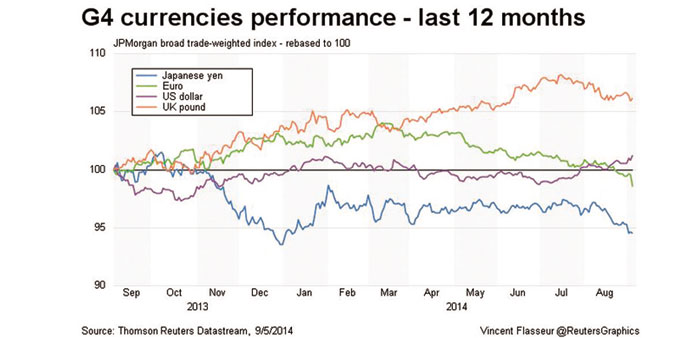The recent sharp slide in the euro currency promises some much-needed breathing space for European companies, reviving hopes for a rebound in due course in corporate profits in the region.
After proving a major headwind for exporters in the first part of the year, the euro’s 8% drop against the US dollar and 5% drop against a basket of major currencies should give a boost of 3 to 6% to corporate earnings, analysts and fund managers predict.
Industrial and pharmaceutical groups which derive the bulk of their revenues from outside the eurozone, such as Siemens and Sanofi, will get the biggest boost, but the positive impact should also spread beyond the global firms if the ECB’s monetary easing measures stimulate economic growth.
The euro hit a 14-month low on Thursday of $1.2920 against the dollar – down nearly 8% from the $1.40 level last May – after the European Central Bank cut interest rates to new record lows and launched an asset purchase programme to ward off deflation.
“Roughly speaking, about 50% of eurozone earnings are coming from outside the region, which means that the retreat in the euro is a major factor for earnings in Europe,” said Romain Boscher, global head of equities management at Amundi, which has €821bn ($1.08tn) under management.
“The drop will take six to 12 months to become visible in corporate results, so we should start to see positive surprises in earnings at the end of the year and early 2015.”
According to Boscher a drop of 10% in the euro trade-weighted index year-on-year translates into a rise of about 8% in corporate profits in the eurozone.
For companies in sectors such as aerospace like Airbus, Safran, Zodiac and Thales which have a big chunk of their sales in dollars while their cost base is mostly in euros the boost will be significant.
For Airbus, one of Europe’s most dollar-sensitive companies, a 10 cents move in the euro against the dollar translates into a €1bn swing in profits at the operating level.
Other companies with a strong exposure to the US market should also be big winners. Italy’s Luxottica, the maker of Ray-Ban and Oakley sunglasses, derives about 50% of its sales from the US, advertising group Publicis about 43%, telecoms equipment maker Alcatel-Lucent 42% and Sanofi nearly a third of its sales, according to data from MSCI.
Giampaolo Trasi, head of equity and credit research at Intesa Sanpaolo, said the more favourable exchange rate should start lifting earnings in the fourth quarter.
“That’s assuming it will remain at current levels until the end of the year. In the fourth quarter of last year the exchange rate moved approximately between $1.35 and $1.38.”
Beyond the industrials and pharmaceutical sectors, Trasi also sees luxury goods producers among the biggest winners of the weakening euro.
Louis Vuitton owner LVMH gets about three quarters of its revenue from outside Europe, with a strong exposure to the US, Japanese and Chinese markets. The impact of a lower currency will also go beyond the automatic effect on repatriated sales revenue, analysts and fund managers said.
“Mechanically, a drop of 10% in the currency represents a rise of 0.2-0.3 percentage points in the euro zone GDP,” said Jean-Paul Betbeze, economic advisor at Deloitte, who sees the euro slipping further in the coming months given the opposing trajectories of the monetary policies of the US Federal Reserve and the ECB.
However, a number of strategists said the currency would need to drop further to really drive a broad-based earnings renaissance in Europe.
Overall, STOXX Europe 600 index firms have posted a 10% rise in second-quarter profits, rebounding after two years of contraction, although revenues dipped during the quarter, in part due to the rising euro.
“The strong euro penalised European companies during much of 2013 and the first half of 2014, particularly the exporters,” said Mathieu L’Hoir, strategist at AXA Investment Managers, which has 582bn euros ($779.41bn) in assets under management.
He estimates a fall of 1% in the euro on a trade-weighted basis represents on average a positive impact of about 0.4 percentage points in earnings growth for eurozone companies.
“The euro is not a headwind anymore, but it hasn’t fallen to the point of becoming a tailwind yet,” L’Hoir said.

